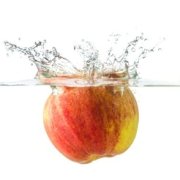Vitamin B2 (riboflavin)
 Vitamin B2 is water-soluble and because it does not get stored in the body we depend on regular intake of the nutrient. Vitamin B2 is also known as lactoflavin and is used as a yellow colouring agent/additive in various foods. When ingested in very large quantities vitamin B2 causes the urine to turn highly yellow. Vitamin B2 is destroyed by light, heating, and alcohol.
Vitamin B2 is water-soluble and because it does not get stored in the body we depend on regular intake of the nutrient. Vitamin B2 is also known as lactoflavin and is used as a yellow colouring agent/additive in various foods. When ingested in very large quantities vitamin B2 causes the urine to turn highly yellow. Vitamin B2 is destroyed by light, heating, and alcohol.
Functions and importance for
- Energy metabolism (especially the turnover of protein but also carbohydrate and fat)
- Energy levels
- Nervous system
- Mental balance
- Skin, hair, and nails
- The condition of lips and tongue
- Maintenance of mucous membranes
- Iron metabolism and maintenance of red blood cells
- Normal vision
- Homocysteine level in blood
- Antioxidant that protects against free radicals
- Reduction of fatigue and exhaustion
- Effect of vitamins B6 and B3
Deficiencies and poor utilization may be caused by
- Large alcohol consumption
- Unbalanced diets
- Overconsumption of sugar, coffee, and other stimulants
- Hormonal imbalances (because the thyroid gland controls the uptake of vitamin B2)
- Sedatives, antibiotics, sulfa drugs, diuretics, and Busulfan/doxorubicin against cancer
- Impaired intestinal flora
- Stress
Deficiency symptoms
Minor deficiency:
- Fatigue and weakness
- Dry lips
Major deficiency:
- Wounds and cracks at the corners of the mouth and on the lips
- Tongue infection with discolouring of the oral mucosa (glossitis)
- Scaly and greasy skin (seborrhea)
These symptoms may also be caused by a lack of efficacy of vitamins B3 and B6, both of which depend on vitamin B2.
Sources
Primary sources are offal such as liver and kidneys but other good sources include whole-grain, dairy products, eggs, legumes, almonds, nuts, seeds, kernels, vegetables, and brewer's yeast.
Content of vitamin B2 (riboflavin) in mg per 100 grams
| Beef liver | 3.0 |
| Egg yolk | 0.4 |
| Cheese | 0.3 |
| Sunflower seeds, spinach | 0.2 |
| Avocado, cauliflower, leeks | 0.1 |
Recommended daily allowance (RDA)
Adults: 11 years of age and older: 1.4 mg
Pregnancy and lactation: 1.6 and 1.7 mg
Children: 1-10 years of age: 0.8 mg
Increased need
- The above mentioned deficiency symptoms
- Pregnancy and lactation
- Overconsumption of alcohol
- Long-term disease
- Increased energy turnover - including sports performance
- Unbalanced diets and weight loss programmes
- Use of certain medical drugs (diuretics, chloramphenicol, tricyclic antidepressants, antipsychotics)
Important information
Supplements of vitamin B2 should generally be taken together with other B vitamins and not together with antacids.
Overdosing - side effects
As vitamin B2 is water-soluble and excess amounts of the nutrient are excreted in the urine it is not possible to overdose on it. Large dosages may cause the urine to turn highly yellow but this is harmless. Very large quantities may cause itching, numbness, sensitivity to light, and a tingling sensation.
Interactions
Vitamin B2 may interfere with the uptake and efficacy of tetracycline antibiotics (broad-spectrum antibiotics). For that reason, vitamin B2 and tetracyclines should be taken at different times of the day.
- Created on .












 "After about one week of taking the Q10 supplement I could feel a huge difference," says 23-year old Alan Piccini, who has been suffering from extreme fatigue and muscle aches ever since he was a child.
"After about one week of taking the Q10 supplement I could feel a huge difference," says 23-year old Alan Piccini, who has been suffering from extreme fatigue and muscle aches ever since he was a child. “Taking capsules with co-enzyme Q10 has freed me of the severe side effects of my cholesterol lowering medicine,” Mrs Franken explains.
“Taking capsules with co-enzyme Q10 has freed me of the severe side effects of my cholesterol lowering medicine,” Mrs Franken explains.